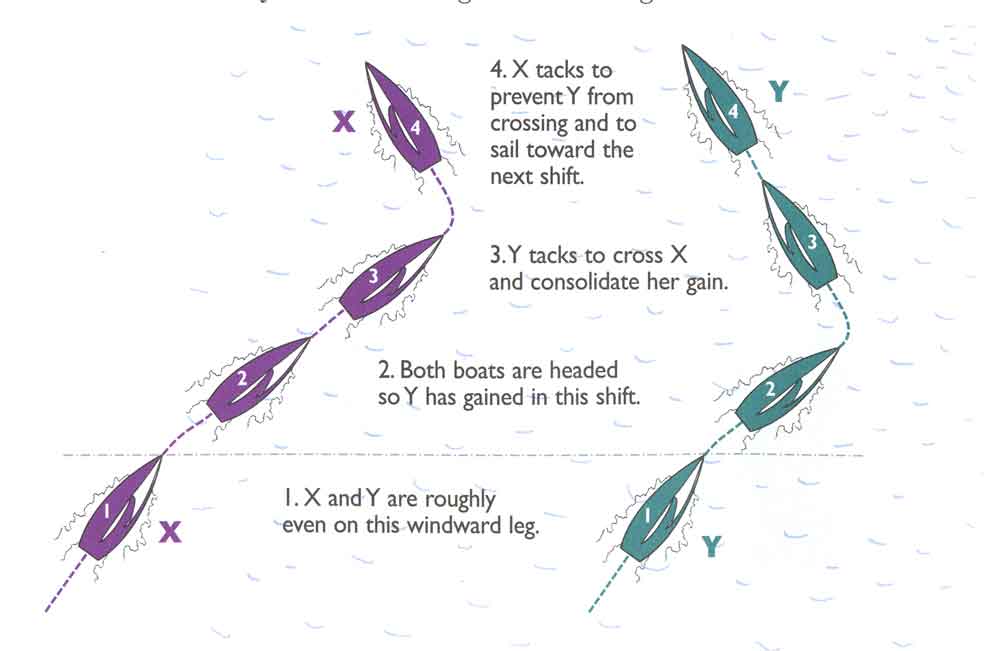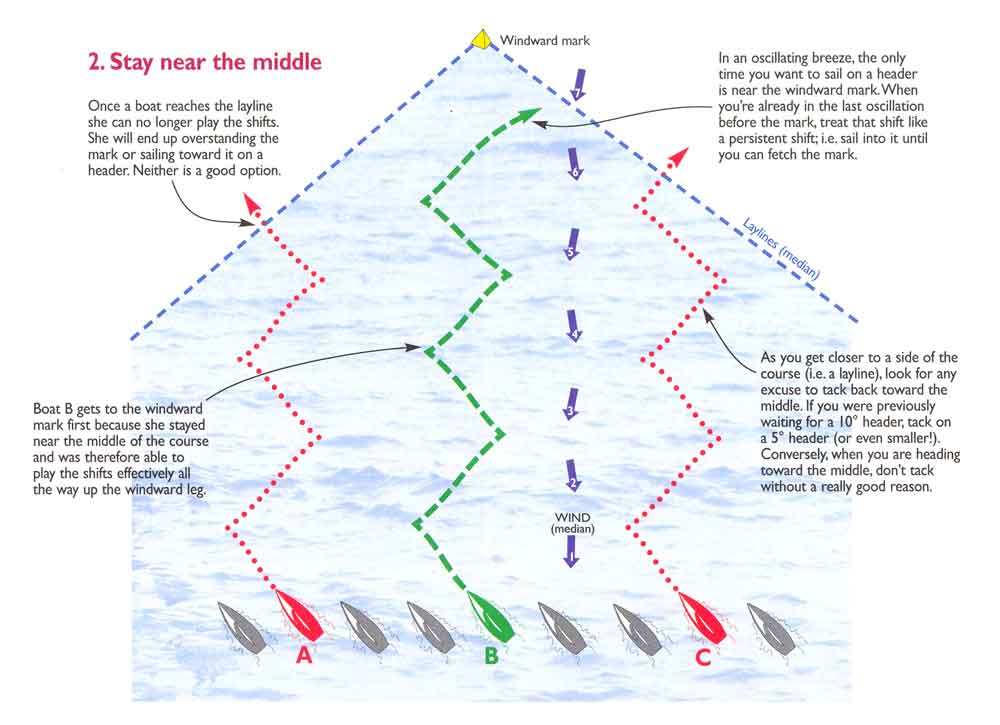
Strategies for Oscillating Shifts
by David Dellenbaugh
When the wind is shifting back and forth (as it usually is) the key to a
successful first beat is catching the initial shift after the start and then
staying “in phase” with the windshifts until you reach the first mark. Here are
some ideas on how to accomplish that:
Choose a ‘median.’
The most important thing for playing windshifts is finding the median, or
average, wind direction. This is typically the direction that’s half way between
the farthest left shift and the farthest right shift you’ve seen. Since you
can’t go head to wind (to find the wind direction) while you’re racing, what you
really need are your close-hauled median headings. These are the compass courses
you steer on port and starboard tack when the wind is at its median.
During the course of a race, the average wind direction might shift slightly to
the left or right. Make sure you keep an eye on this, and don’t be afraid to
adjust your median numbers accordingly.
Use your median.
Once you’ve determined the median headings, you will always know whether you are
lifted (sailing higher than the median) or headed (sailing lower than the
median). If you are sailing below your median, you should normally tack. By
tacking on the header you will have a lift on the other tack.
In my opinion, it’s more important (and easier) to know the range of the
oscillations than their timing. However, there are two situations on the first
beat where it can be helpful to know about timing, too. One is at the start when
you’re trying to figure out how soon the first shift will come. Another is near
the windward mark when you need to know if the wind will shift again before you
get there.
The last shift.
If you are close enough to the windward mark that the wind will not shift again
on this leg, you probably shouldn’t tack on the header like you would normally
do. Instead, treat the last oscillation as if it is a persistent shift (because
it will not oscillate again on this beat). Keep sailing into the header until
you are able to tack and fetch the mark.
 |
Sail in bad air?
In most situations you want to avoid sailing in bad air at almost any cost. Wind
shadows make you go slower and point lower. The longer you stay in them, the
more you’ll lose to boats sailing in clear air.
In oscillating winds, however, it might not be a terrible idea to “live” in bad
air sometimes. If you are on a lift, you might lose more by tacking off the lift
than you would by sailing in bad air. This is especially true in moderate or
heavy winds, when the slowing effect of wind shadows is not so great.
Choosing lifts or puffs.
When the wind is oscillating in direction, it is also likely to have variations
in velocity (i.e. puffs and lulls) across the course. And sometimes you have a
tough choice - either sail on a lift or sail toward a puff. Which is better?
Your strategy will depend on several factors, but primarily on the overall wind
velocity. If there is already a lot of breeze, a puff won’t make much
difference, and you should probably go for the lift. But if the wind is light, a
puff can give you a huge speed boost (and also a lift because you can sail
higher in more breeze), so it may be worth sailing on a header to get there.
4 Keep a good lookout.
An oscillating breeze changes all the time, so you really have to keep your head
out of the boat in order to sail fast. One idea is to assign a crewmember to
look for shifts.
If there’s another fleet of racing boats to windward, these make great wind
indicators. Watch other “telltales” such as smokestacks, flags on shore, flags
on stake or committee boats, the swing of anchored boats, and so on. Try to
discover a pattern between the actions of these indicators and subsequent
changes in the wind.
The other boats in your fleet are also good telltales, especially if they split
to opposite sides of the course. And whenever you cross close to another boat,
keep an eye on them the next time you come together to see if you have gained or
lost.
Play the middle.
When the wind is oscillating, it usually works to play the middle of the course
(one exception is light air and large fleets when the sides usually seem to
pay). If you are sailing away from the middle, look for good reasons to tack;
when you are sailing toward the middle, don’t tack unless you have a very good
reason (see the diagram above).
This strategy keeps you away from the laylines, which are deadends in a shifty
breeze. By staying near the middle, you should be able to take full advantage of
every shift up to the windward mark.
 |
Don’t chase shifts.
When you see a boat nearby on a huge lift, it is tempting to sail toward that
shift and try to get it. However, this rarely works. More often than not, you
must sail on a header to reach the other boat. And when you get there, the shift
is usually gone.
You will probably be more successful if you focus on sailing in the wind you
have. Use other boats as a guide to know how much you are lifted or headed, but
don’t try to sail for their shift (unless it’s light air and you’re going for
pressure).
Covering in shifty winds.
It’s very difficult to “cover” other boats when the wind is oscillating. By
covering, I mean staying upwind of the other boat, or between them and the
windward mark. If you try this in an oscillating breeze, however, you are likely
to lose.
That’s because if the boat you are covering is playing the shifts correctly, you
won’t be (since you are almost always in a different part of the oscillation
than they are). In shifty winds, your main priority is to sail your own race -
then worry about other boats.
Sail fast on lifts.
If you are sailing on a lift (and you should almost always be sailing on a lift
when the wind is oscillating!), you should sail just slightly lower and faster
than normal (assuming you will get at least one more oscillation on the beat).
This will get you to the next shift sooner and maximize your VMG in the
direction of the median wind.
Consolidate your lead.
If the value of your stocks goes up, you won’t realize an increase in wealth
unless you sell those stocks before they go back down. Playing windshifts is
very similar. If you get headed you will gain on all the boats to windward and
behind. But you won’t be ahead until you tack and cross them.
Dave publishes the newsletter Speed &
Smarts. For a subscription call:
800-356-2200 or go to:
www.speedandsmarts.com